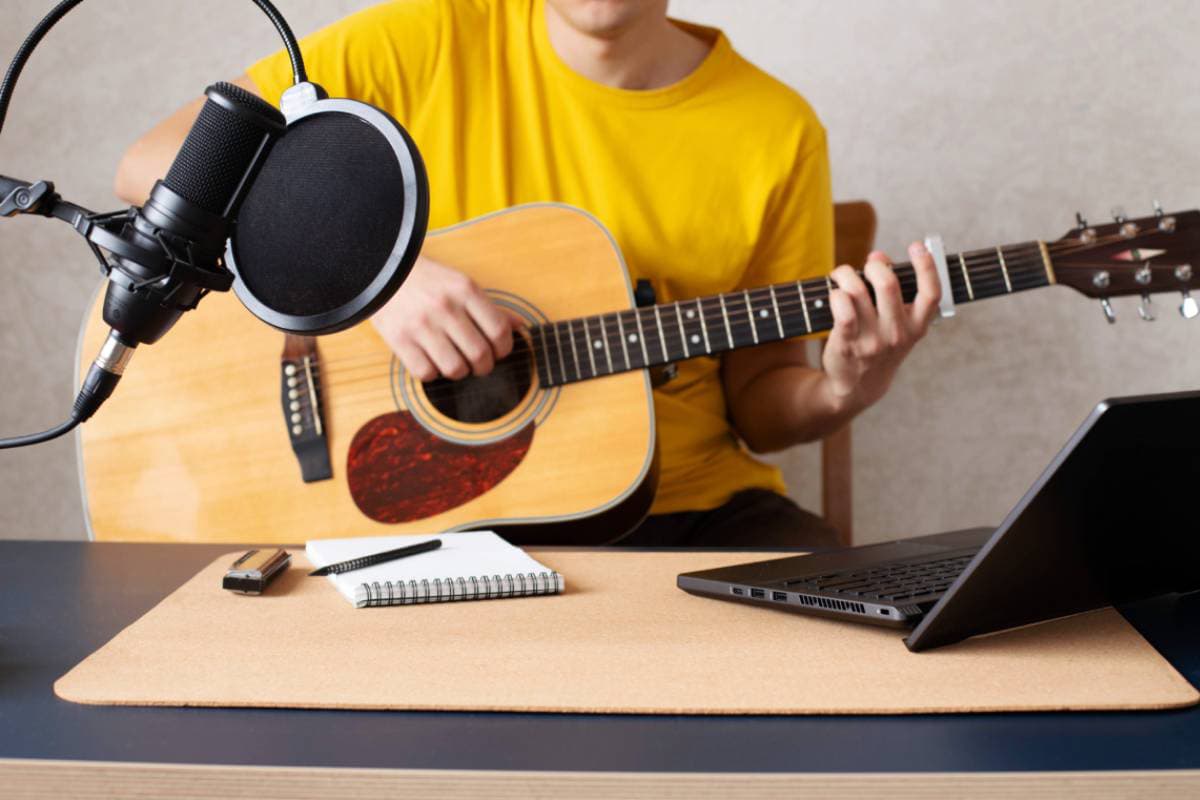Audio interfaces are an indispensable tool in every home studio. They allow you to connect your instrument to your computer easily and then record, mix, and master your riffs in the DAW of your choice. Unfortunately, you may not always have an audio interface close by, so you’ll have to get creative if you want to share your ideas or record a riff and not forget it.
Here are a few ways to record guitar without an audio interface:
- Connect the amp to the computer.
- Plug the guitar into your computer.
- Record with your phone.
- Record with your laptop.
- Use a microphone.
- Record with a cassette recorder.
- Opt for virtual instruments.
Let’s go through these tips to see what you can do if you want to record yourself playing without an audio interface. You’ll also have to experiment a little, but you’ll know where to start, and you’ll soon be able to create good recordings without an audio interface.
👇😀👇NOTE👇😀👇
If you want to find out what my recommended guitar gear is, then here is what I recommend on Amazon:
- Fender Cutaway Acoustic-Electric Guitar Bundle (MY FAVORITE GUITAR)
- Snark SN-8 Super Tight All Instrument Tuner (Easiest Tuner I’ve Used😏)
- 6 String Acoustic Guitar Capo (Best CAPO for quick changes)
- Dunlop Max Grip 1.0mm Nylon Picks (Thick Guitar Pick So You Don’t Lose Grip!)
- Universal Guitar Stand (Cheap & Minimalist Guitar Stand I Recommend)
- Levy’s 2″ Wide Quick Adjust Guitar Strap (Best Guitar Strap For Any Level)
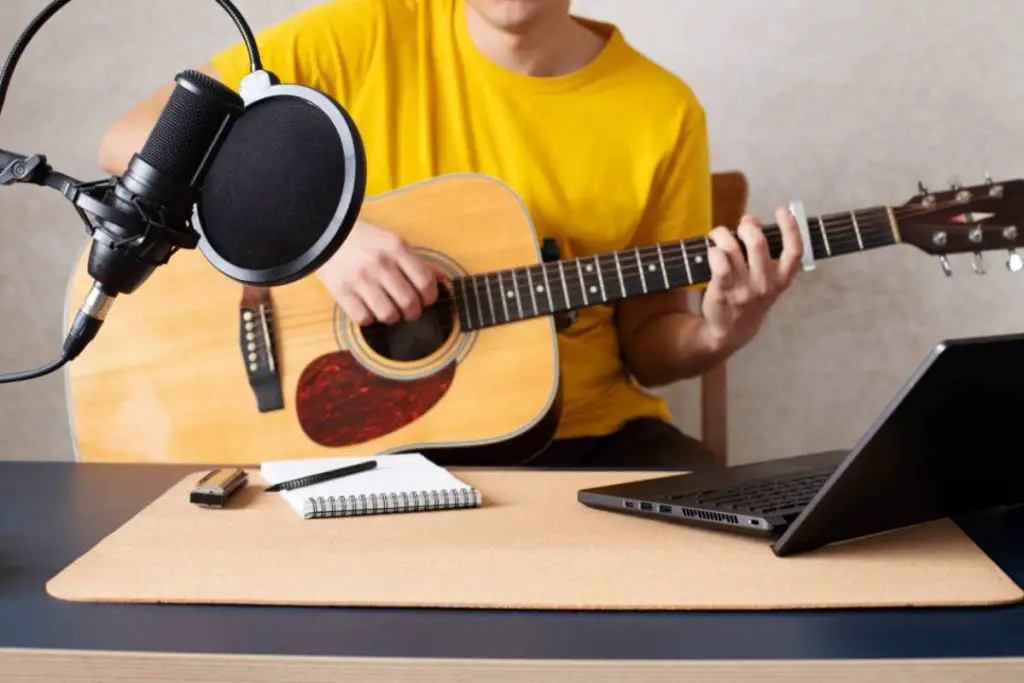
1. Connect the Amp to the Computer
Typically, connecting your guitar amp to your computer requires an audio interface. This is not a must, though. An audio interface will make your recordings sound much better, but you can forgo it and connect your amp directly to your computer.
There are two caveats here:
- It won’t sound as good as it does when using an audio interface.
- Not every amp has this option.
These two factors are important to remember, but they probably won’t matter much to you, as you’re likely not looking to make professional recordings this way. This trick will do just fine if you’re only looking to track your progress or share your ideas.
There are two ways in which you can connect your amp to your computer:
- Via the headphone/line out socket.
- Via USB.
Let’s examine how you can pull this off, so you can see if this method works for you.
Headphone/Line-Out Socket
To record guitar this way, you can plug your cable in the headphone or line out socket on your amp and then into the mic input on your computer. You’ll most likely need an adapter that converts the 6.5 mm plug into a 3.5 mm plug.
Once you’ve connected the guitar to your computer, turn on your DAW, set everything up to your liking, and start recording. You should not expect great results unless you have a high-end sound card. The average sound card is not made for recording, but for simple daily tasks like listening to music or watching films, so don’t expect much from it.
You should also note that this method bypasses your amp’s speaker, so your guitar will sound much different than it usually does. However, you can offset this by using an amp sim and making your guitar sound like any guitar you wish. Another option is to use a speaker-emulated output, if your guitar has one, or impulse response, if your DAW includes it.
USB
Many modern guitar amps include USB jacks, which is an awesome way to connect your amp to your computer. Using USB is probably the best way to record your guitar if you don’t have an audio interface because it doesn’t require any additional investments and causes less audio quality loss. If your amp has USB connectivity, don’t look for other options if you want to record your guitar without an interface.
You only have to plug a USB cable into your amp and computer, open your DAW, and start jamming. You’ll get pretty good sound quality this way, but it is still a good idea to use an amp sim to improve it a little more.
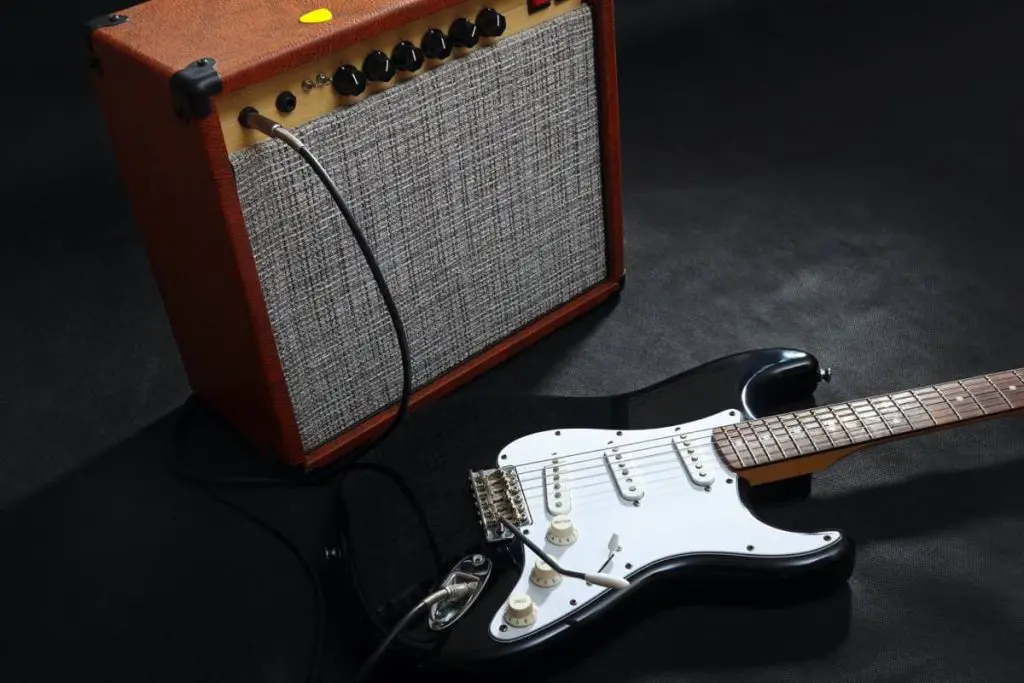
2. Plug the Guitar Into Your Computer
This is a very budget-friendly recording option. It is super simple, but it usually doesn’t give great results, so you have to be reasonable with your expectations if you’re using this method. Despite this, it is a good way to make a quick and short recording if you’ve just had a great idea and want to let a friend hear it or save it for later.
You only need an adapter that will let you plug your guitar into your computer (you should have one anyway since they come in handy) and a working mic jack (which goes without saying), and you’ll be ready to record.
You’ll have to choose an amp sim, which lets you get quite creative, as you can choose the sound of pretty much any amp in the world and possibly get an even better effect than with your real amp.
On the flip side, this method can cause various problems, mostly because of your sound card. As it’s not equipped to handle a guitar plugged directly into it, you can expect to hear lots of noise, especially with certain guitar sims. This tends to happen, especially when you’re using a heavier guitar sim for down tuned chugging or if the volume on your guitar is turned up a lot.
It’s advisable to turn the volume knob on the guitar down and to use a guitar sim without too much distortion. If you want to be louder, turn up the volume on your speakers.
While you won’t achieve spectacular results with this, you’ll get a relatively decent recording, good enough if you want not to forget your ideas or share your new riffs with your bandmates.
3. Record With Your Phone
Smartphones have come a long way; many are now equipped with high-end microphones. This means that you might have a decent recording device in your pocket. If you need to record something quickly, you can take it out and start recording immediately.
This recording technique is particularly good for acoustic guitars and vocals. Sometimes, you can even find singles recorded on high-end Samsung phones, which means this method is more than suitable for quick and short recordings.
Of course, you’ll have to invest some time in experimenting until you find the right position for your phone and the right distance from your guitar. This will vary from guitar to guitar and song to song, so you’ll have to experiment before each recording.
You can also record an electric guitar this way, but the sound quality you’ll get will likely be sub-par. You will be able to hear the melody you’re playing, but it’s likely to get pretty distorted unless you play quietly and without overdrive. Of course, the results will vary based on your phone’s microphone, so if you have a lower-end phone, you can expect worse results and vice versa.
But, if a riff idea has just popped into your head, or you’ve thought of a particularly funky rhythm or a cool way to play a chord, making a recording this way will do the trick until you’ve found a better way to record.
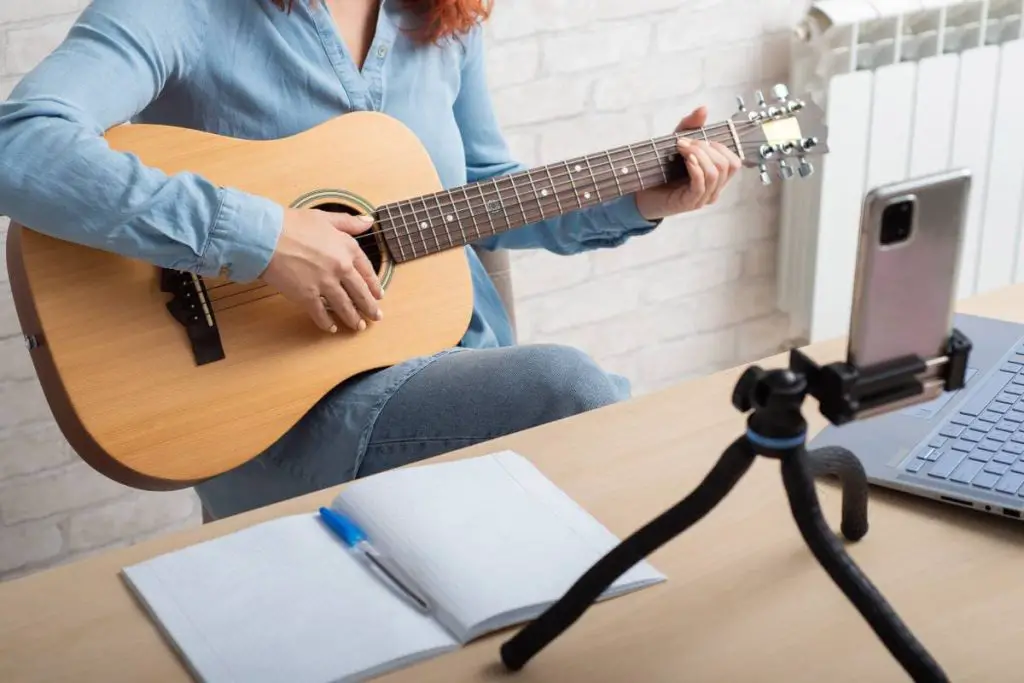
4. Record With Your Laptop
Just like your phone, your laptop also has a built-in microphone that you can use to record yourself. The results will also vary widely, but they typically won’t be mind-blowing. The microphone on your laptop is only meant to capture your voice when talking to someone on Zoom or Skype if you don’t have an external microphone.
You might have a laptop with a particularly good mic, but it’s still not great for recording. However, if nothing else is available, you can download a simple recording tool, open it, and start playing.
Just like when using a phone, you’ll get better results with an acoustic guitar since it will make less noise than its electric counterpart. You’ll also need to play around with the laptop to find the best (or better said, the least bad) position for recording. While the results won’t be great, they will be better than nothing.
5. Use a Microphone
If a microphone is meant to capture sounds, why shouldn’t you use it to capture and record the sound of your guitar? Besides, you’d most likely record by miking your amps even in a studio. The only difference is that you’re skipping the audio interface this way, which probably won’t produce stellar results, but you’ll at least get some kind of recording.
USB microphones are recommended for this, especially if they are a bit pricier and not made exclusively for video calls. USB microphones are a good choice because they typically provide a better sound quality than mics with 3.5 mm plugs.
There are some things to keep in mind when recording this way:
- You need a good amp.
- You have to adjust the sound, tone, and gain on your amp to prevent too much distortion.
- You need a room with good acoustics.
- Your room has to be isolated from outside noise.
If a good USB microphone is unavailable, you can use any microphone. If you have a cheap recording microphone lying around, it will do the trick. You can even use a low-end mic for video calls, if nothing else is available. And if you’re really on a budget thinner than a shoestring, you can use the microphone on your headset, but prepare for an amazingly bad sound.
You can also invest some time in polishing these recordings in your DAW to eliminate the noise and make the recording more listenable, but it is not certain if you will get anywhere. It is relatively hard to polish a recording made with such rudimentary tools, especially if there’s a lot of distortion and background noise, so you may as well leave it as it is.
However, this is not a particularly bad way to record yourself without an audio interface. You’ll probably get a better recording than when using the built-in microphone on your laptop, tablet, or phone, at least most of the time.

6. Record With a Cassette Recorder
If you’ve got an old cassette recorder, you can go full vintage and make some analog recordings. Of course, you can always turn these analog recordings into digital later, but it might be a cool experiment to make some recordings this way.
While it may not be financially viable to buy a dedicated cassette recorder, you might have one left from your parents or grandparents, and if it’s working, there is no reason why you should not use it. You might even score some cool points for using such a vintage recording technique. As long as you can find some blank cassettes, you’re good to go.
Generally, you can run into two kinds of cassette recorders. There are basic cassette recorders for recording voice, particularly during interviews, and dedicated multi-track cassette recorders for recording music. The latter option is preferable, of course, but even a basic cassette recorder can record your guitar to some extent.
If you can get your hands on a real multi-track cassette recorder, you can create some high-quality recordings with a special feel to them. You’ll probably get a more authentic guitar sound, and your playing will come to the forefront since you won’t be able to hide anything or make major edits. So it’s just you and your skills, and you’ll be able to truly showcase what you’ve got.
Let’s briefly examine what recording with a cassette recorder will look like.
How To Record Guitar With a Cassette Recorder
Recording with a cassette recorder will feel different from recording on your computer with an audio interface. You will be limited by the physical space on the tape, and the convenience of digital mixing will disappear.
Most cassette recorders are four-track recorders, so you can record up to 4 instruments at once. For example, you can plug a drum machine into it and play over that. Or, you can choose to record nothing but your guitar.
To record guitar this way, you have to:
- Plug your guitar into the recorder or mic your amp and plug the mic into the recorder.
- Adjust the sound and volume. This might take a few tries.
- Press record and play.
- Press stop and rewind to hear your recording.
As you can see, it’s a simple process if you want to make a quick, one-track recording. It gets more complicated if you want to produce an entire song, but it is essentially straightforward. It is a bit like having an audio interface and a rudimentary workstation in the same device, but without the convenience of digital technology, so you’ll need some time to get used to it.
On the other hand, if you’ve only got access to a simple cassette recorder for recording voice, you simply put a cassette in it, press record, and start playing. The sound quality will be inferior to the one you’ll get from a cassette recorder for music, but at least you’ll have some kind of recording.
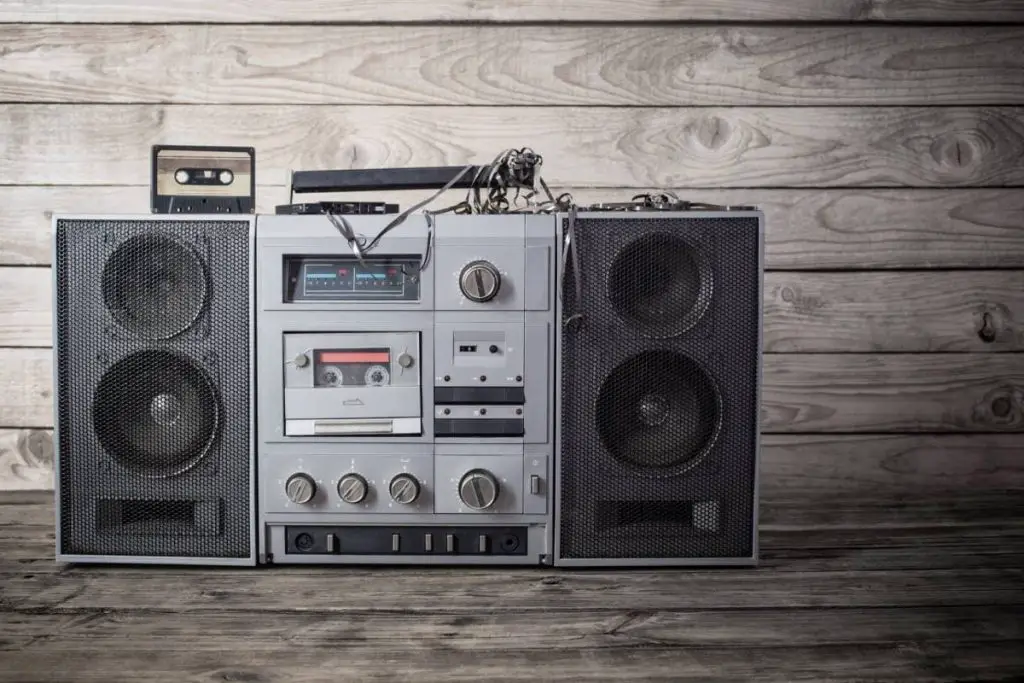
Record With a Boombox
Old school boomboxes could record sound, apart from putting it out. You can use this if you have an old boombox and want to make a quick and easy analog recording. You only need a blank cassette and some time to play around and find the position that records the least noise.
This is much simpler than using a cassette recorder, but you also won’t get results that are as good. You take some, you lose some. But, it’s an interesting idea to play around with, so you might try it.
7. Opt for Virtual Instruments
What if I told you that you could record your guitar without even using your guitar? Of course, that would be cheating since the process doesn’t involve recording, but it might be a good way to get your ideas across if there is no good way to record yourself playing.
There is a wide variety of virtual instruments you can find, even if you only stick to free software, so you’re bound to find something that you like and suits your purpose. There have been producers who have created entire orchestral scores only using virtual instruments, so it follows that you can create guitar riffs this way.
You can even do this on your iPhone if you have one and you use GarageBand on it. While it’s probably not as convenient as producing music on your computer, it is still an option you might give a try.
One major downside to this is that there is quite a learning curve, especially if you’ve had no prior experience with this. You’ll have to invest a couple of days or even weeks in learning to produce riffs using only virtual instruments, so it’s not the best idea if you need to do it quickly.
On the other hand, this way is guaranteed to give you high-quality recordings. Even if they sound somewhat robotic, there will be no noise or interference, so it will sound pretty good. However, if you’re looking to create demos or EPs, it’s best to stick to real instruments, as using virtual instruments is often frowned upon, especially when it comes to guitars.
Conclusion
So, there you have it. There are many ways to record guitar without an audio interface. You will not get studio-level results, but it will be good enough for sharing your ideas with friends or keeping track of your progress. The best way to do this is to connect your amp to your computer or to plug your guitar into it.
👇😀👇NOTE👇😀👇
If you want to find out what my recommended guitar gear is, then here is what I recommend on Amazon:
- Fender Cutaway Acoustic-Electric Guitar Bundle (MY FAVORITE GUITAR)
- Snark SN-8 Super Tight All Instrument Tuner (Easiest Tuner I’ve Used😏)
- 6 String Acoustic Guitar Capo (Best CAPO for quick changes)
- Dunlop Max Grip 1.0mm Nylon Picks (Thick Guitar Pick So You Don’t Lose Grip!)
- Universal Guitar Stand (Cheap & Minimalist Guitar Stand I Recommend)
- Levy’s 2″ Wide Quick Adjust Guitar Strap (Best Guitar Strap For Any Level)

